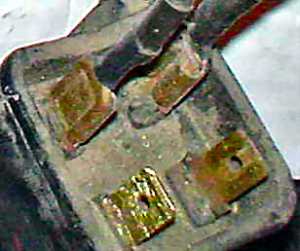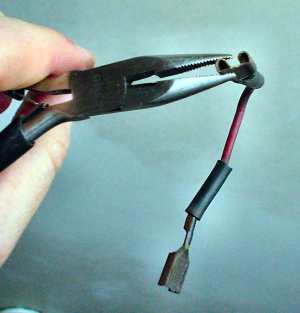
Now a poor connection is introduced in the
connector and it's resistance increases by only 1ohm.
- The battery's job is still to maintain
+13V.
- The amount of current drawn is still
determined by the load on the battery (which has now increased by 1ohm)
(1.86ohms + 1ohm= 2.86ohms). In this case the load is the
resistance of the pump AND the resistance of the connector corrosion. You
can also see that this results in lower voltage applied directly to the
pump. It has dropped from 13V to 8.5V!!
- So the resistance of the pump AND the
connector is what "draws" current from the battery. In this second
case it is 4.5A (Ohm's Law I =V/R = 13 / 2.86). The corrosion causes the
current through the pump to drop from 7A to 4.5A.
So if you look at the specs for a typical fuel
pump.....
- For 7 Amps ~ 70gallon per hour @
45psi
- For 4.5Amps ~ 70gallon per hour @ 15psi
Bottom line: Fuel pressure and/or flow decreases
because of a corroded connector!
Sensor and EFI Circuit Corrosion
It is important to realize that corrosion can cause the same problem in
sensor circuits. For example, a corroded air temperature sensor in the AFM may
fool the ECU into thinking the temperature is lower than it actually is: (sensor
resistance increases as temp decreases). This will result in the ECU into
thinking the the incoming air is colder and denser thus it will add too much
fuel and cause the engine to run rich.
Likewise, corrosion on the water temp sensor will
fool the ECU into thinking the engine is colder than it actually is thus it will
add too much fuel and cause the engine to run rich.
Corrosion on the AFM connections can make the
engine run rich OR lean depending on which connections are corroded.
Corrosion on the Oil Pressure Sender connections
can make the gauge read lower than it actually is.
Corrosion on the Thermotime switch connections
can make the car run rich for a longer period after start up.
Corrosion on the Aux Air Regulator
connections can make the car idle faster for a longer period after start up.
Corrosion on the Boost Control Decelleration
Device connections can make the car idle faster.
Corrosion on the EFI grounds or EFI power cables
can make the EFI system unpredictable.
Corrosion on the injector connector can make make
a cylinder run lean.
Those annoying temp sensor bullet connectors:

Here are the connectors that are 1' upstream from
the temperature sensor and thermo-time switch.
To my surprise the previous owner also had a 330ohm resistor in series with
the temp sensor. I had assumed he simply soldered them together as most do
however, after finally opening up the mile of electrical tape, I found
this! FYI, The resistance at operational temp of 170°F should be 290 to
360ohms.
How to clean electrical connectors:
DISCONNECT
THE -NEGATIVE BATTERY TERMINAL BEFORE REMOVING/DISASSEMBLING OR
RECONNECTING/REASSEMBLING ANY CONNECTOR!!!
Most connectors can be cleaned with an
abrasive... but, some connectors actually have an electrical plating on the
contacts so an abrasive is not recommended for plated contacts.
Here are a some examples of abrasive cleaning

This brass ground ring has been half-cleaned with sand
paper. Sand paper is great when you have easy access to the part.

The other side of the brass ground ring has
been half cleaned by scraping with a knife. This method is great when the part
is not easily accessible.

The brass ground ring has been completely cleaned
with a small file. (My fav tool).
A small wire brush or a dremel tool with wire
brush attachment can also do the job..
Remember
to also clean the other half of the connection. It could be a bolt, locking
washer and nut, connector pin, etc. (Wire brushes work great for bolts).
When the contacts are plated, simply using a
contact cleaner is best. An old tooth bush helps do the job. If the connector's
plated pins are very corroded, then you may have to scrape them with a knife. Be
sure to follow up with a final contact cleaner squirt as it coats and protects
the metal. Don't forget to do both parts of the connection.



Alcohol (rubbing alcohol, isoproponal, etc) is good for
a quick fix but it does not have metal protectants so it is not the best
solution. Electronic control cleaners such as the MG Chemicals product work
great, however; most recommended is Caig Deoxit. It cleans, deoxidizes and
protects.
Here are two connectors that were cleaned with
Caig Deoxit and a brush. (Before and After shots). It is difficult to see but
the pins went from dull greeny-brown (left) to shiny silver (right). You can also see how the Deoxit
oily film covers everything evenly.


Tune Up Grease is an electrical insulator developed
for high voltage connections (distributor, coil and plugs). It is not
recommended for sandwiching in low voltage connections as it prevents
conductivity, however, after the low voltage connection is cleaned, sprayed with Deoxit and
reconnected, Squirting Tune Up grease on the outside of the connection acts as a
good way to prevent water from working into the connection and beginning the
oxidizing process. It also helps keep the Deoxit oils inside the connection as
the engine temp can evaporate them. Use this stuff after reconnecting.

Fusible Link "Refreshing" Details

Disconnect fusible link

Clean blade connection using an abrasive method from
above (file, knife,sandpaper)

Lower left blade has oxide scraped off

Scrape oxide from inside of connector where it contacts the blade. No need to
worry about the outside.

Gently pinch connector lobes so that it firmly grips
the blade.
Spray with Deoxit and reassemble
![]()



















